Duong Lam, a hidden gem nestled in Hanoi, is more than just a village; it’s a living museum preserving the soul of the Northern Vietnamese countryside. Here, time seems to slow down, embracing the ancient laterite stone houses, the brick paths reflecting the shadows of old banyan trees, and the echoes of centuries of history. Visiting Duong Lam ancient village is not just “traveling,” but “returning” to cultural roots and cherished traditions. Join “Du lịch khắp thế gian” (Travel the World) as we explore the Duong Lam ancient village travel guide, to fully appreciate the beauty and value this place offers.
Location and How to Get to Duong Lam Ancient Village
Duong Lam ancient village is located in Son Tay town, Hanoi city, just about 44km west of the capital’s center. This location is not too far, making it easy for you to escape the hustle and bustle of the city and find the peaceful, tranquil space of the countryside. Duong Lam is not simply one village but a unification of 9 ancient villages, among which the most famous are Mong Phu, Dong Sang, Cam Thinh, Cam Lam, and Doan Giap villages. The close connection between these villages creates a unified and harmonious cultural complex, deeply imbued with the identity of the Northern Delta region.
To get to Duong Lam ancient village, you have several transportation options to suit your preferences and budget:
1. Bus: This is an economical and convenient public transportation option. From the center of Hanoi, you can take bus routes No. 71 (My Dinh – Son Tay Bus Station) or 73 (My Dinh – Chua Thay). The bus will take you to Son Tay bus station, from where you can easily take a motorbike taxi or taxi to Duong Lam ancient village. Bus fares range from 9,000 to 12,000 VND/trip.
2. Motorbike or Private Car: If you love freedom and want to actively explore Duong Lam in your own way, a motorbike or private car is an ideal choice. You can travel along Thang Long Avenue, turn right at the Hoa Lac intersection onto National Highway 21, then go straight to Son Tay and follow the signs to Duong Lam ancient village. The route is quite easy and convenient.
3. Coach: Some coach routes from My Dinh to Phu Tho may also stop in the area near Duong Lam. You should ask the bus operator in advance to ensure a suitable route. Coaches are a more comfortable option than buses if you are traveling in a large group or carrying a lot of luggage.
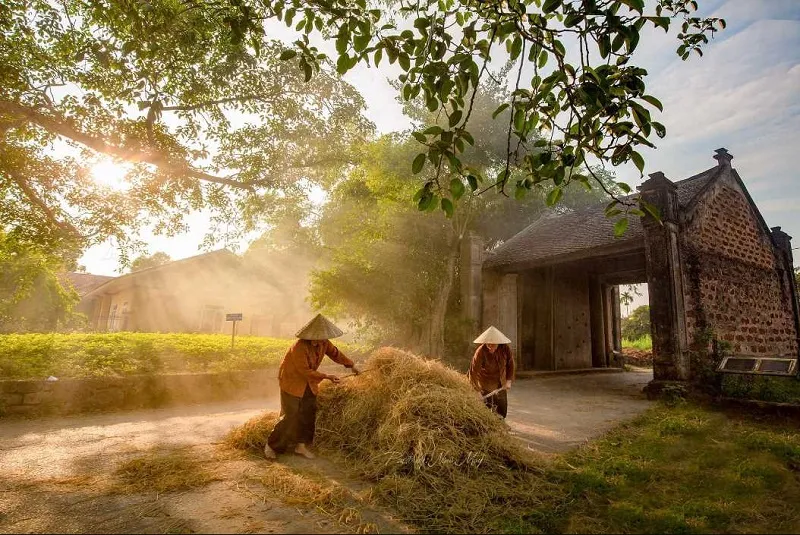
Whichever means of transport you choose, the journey to Duong Lam will be an enjoyable experience, the beginning of your exploration of the unique cultural and historical values of this ancient village.
Discover the Unique Architectural Beauty of Duong Lam Ancient Village
Duong Lam captivates visitors with its unique architectural beauty, deeply rooted in the traditions of the Northern Vietnamese countryside. This place is known as the “museum of ancient Vietnamese village architecture” with hundreds-year-old laterite stone houses, winding alleys, and ancient communal houses, pagodas, and temples.
1. Mong Phu Village Gate and Ancient Banyan Tree
Stepping into Duong Lam ancient village, the first impression is the majestic Mong Phu village gate, built in 1833. The village gate is not just an entrance, but also a symbol of the village, witnessing many historical ups and downs. Right next to the village gate is a 300-year-old banyan tree, its canopy spreading like a giant umbrella, shading a large area. The village gate and the banyan tree create a scene that is both ancient and poetic, a must-check-in spot for all visitors.
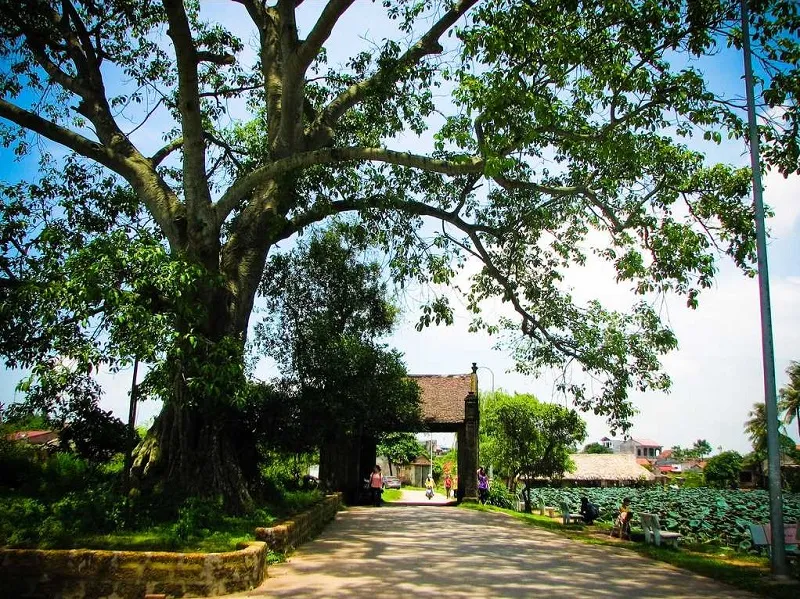
The roads in the village are paved with red bricks or laterite stones, winding through ancient houses. On both sides of the road are mossy laterite stone walls, stained with time, creating a peaceful, quiet space, completely different from the noise and bustle of the city.
2. Ancient House of Mrs. Dien
The ancient house of Mrs. Dien is one of the most typical ancient houses in Duong Lam, dating back nearly 200 years. The house has a distinctive Northern Vietnamese traditional architecture with 5 compartments and 2 lean-tos, built entirely of wood and laterite stone. Visiting Mrs. Dien’s house, you will be warmly welcomed by her grandchildren and hear interesting stories about the history of the house and the life of the family through many generations.
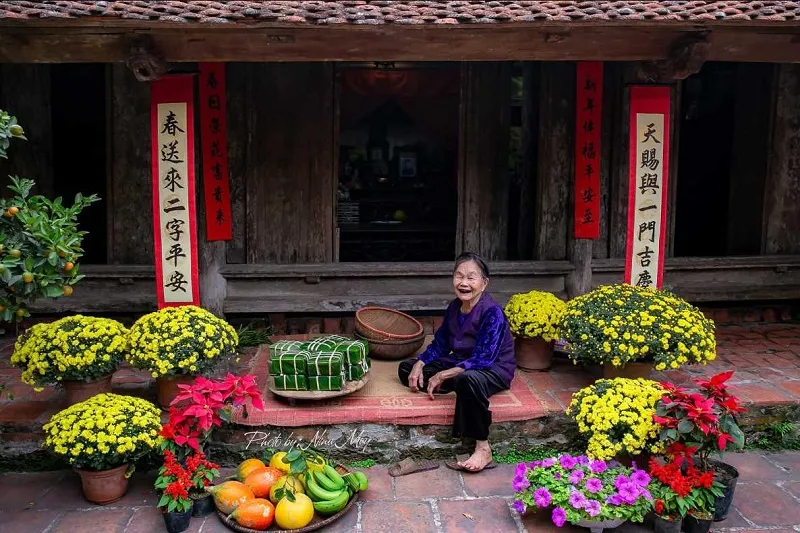
Especially, when visiting Mrs. Dien’s house, do not forget to enjoy vối tea (tea made from vối leaves) and chè lam (sticky rice candy) – rustic specialties of the Northern Vietnamese countryside. In the ancient space, sipping hot tea, listening to Mrs. Dien’s stories, you will feel the warmth and hospitality of the people of Duong Lam.
3. Mong Phu Communal House
Mong Phu communal house is the cultural and religious center of the village, where traditional festivals and community activities take place. The communal house was built nearly 400 years ago, with a unique architecture combining Vietnamese and Muong styles. Mong Phu communal house stands out with its intricately carved gate, spacious stilt house, and solid earthen walls.

Visiting Mong Phu communal house, you will hear stories about Mr. Muc Hung, a talented craftsman who made great contributions to building the communal house. The communal house is not only a unique architectural work but also a place to preserve the spiritual and cultural values of the people of Duong Lam.
4. Ancient House of Mr. Hung
The ancient house of Mr. Hung is considered the oldest ancient house in Mong Phu village, dating back to 1649. The house has been inhabited by 12 generations and still retains its ancient, intact beauty. The gate of Mr. Hung’s house is built of a mixture of sand, rice husks, and mud, creating a strong bond that has lasted for hundreds of years.

Inside the house is a traditional 5-compartment and 2-lean-to space, with 3 compartments for ancestral worship and 2 compartments for receiving guests. The yard is paved with Bat Trang bricks, and there is an ancient well, all creating a living space imbued with the old days, giving visitors a feeling of stepping back into the past.
5. Ancient House of Mr. The
The ancient house of Mr. The is famous for its unique “no iron nails” architecture. The large 7-compartment house is connected entirely by mortises, in the traditional tiled roof style. Visiting Mr. The’s house, you will feel the living space imbued with the Northern mountainous region, with corn cobs hanging in front of the porch and the characteristic aroma of tương Bần (Ban fermented soybean paste) – a famous specialty of Duong Lam.
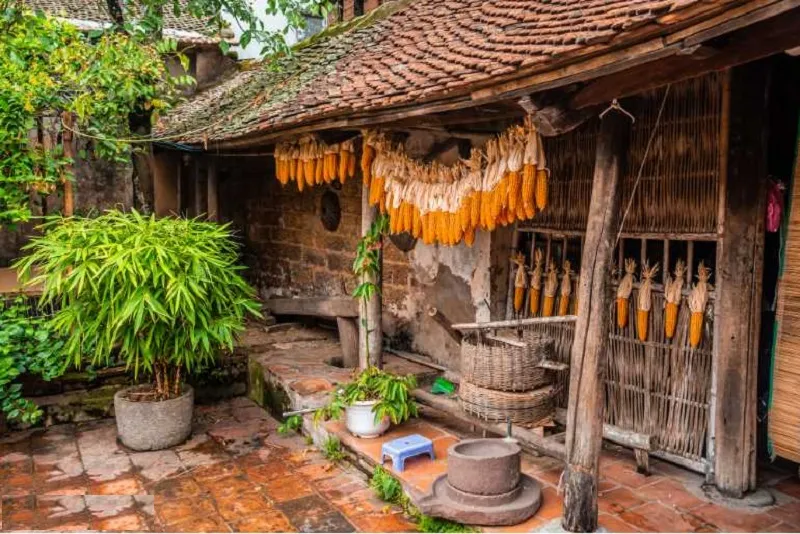
Visiting the ancient houses in Duong Lam, you will not only admire the unique architectural beauty but also learn about the history, culture, and life of the people here. Each house, each alley, contains its own stories, contributing to the special attraction of Duong Lam ancient village.
Experience the Unique Culture and Cuisine in Duong Lam
Coming to Duong Lam, you will not only admire the scenery but also experience the unique culture and cuisine of the Northern Vietnamese countryside.
1. Village Culture and People of Duong Lam
The people of Duong Lam are famous for being hospitable, friendly, and simple. Coming here, you will feel the hospitality and openness of the locals. Spend time chatting with the villagers, listening to them tell stories about the village and neighborhood, and you will learn more about the lifestyle, customs, and traditional cultural values that have been preserved through generations.
Duong Lam still retains the characteristic community cultural activities of Vietnamese villages. You can see images of grandmothers and mothers sitting and preparing betel leaves, chewing betel in front of their houses, or groups of young people gathering to play chess or đánh đáo (a traditional game) in the communal house yard. During festivals, you will immerse yourself in the bustling atmosphere of traditional cultural activities such as chèo singing (traditional opera), water puppetry, or folk games.
2. Duong Lam Cuisine: Hometown Flavors
Duong Lam cuisine is imbued with rustic, simple yet delicious and attractive countryside flavors. The local specialties here are prepared from fresh ingredients, according to traditional recipes, bringing a unique flavor that cannot be confused with anywhere else.
Some dishes you should not miss when coming to Duong Lam:
- Mia Chicken (Gà mía): A specialty chicken of Duong Lam, with firm meat, crispy skin, and delicious aroma. Boiled mia chicken is the most popular dish, often used in festivals and offerings.
- Thịt quay đòn (Rolled Roasted Pork): A unique dish, elaborate in preparation. Pork belly is marinated with spices, rolled up, and roasted over charcoal until golden brown and fragrant. The special flavor of thịt quay đòn comes from young guava leaves, which are minced and mixed into the meat marinade.
- Chè kho (Sweet Green Bean Pudding): A rustic sweet soup, made from cooked green beans, mixed with sugar and a little banana oil. Duong Lam chè kho has a mild sweetness, buttery taste, and is perfect for enjoying on hot summer days.
- Tương gạo (Fermented Rice Paste): A familiar dipping sauce in the meals of Duong Lam people. Tương gạo is handmade from sticky rice, soybeans, and salt, naturally fermented, with a rich, characteristic delicious flavor.
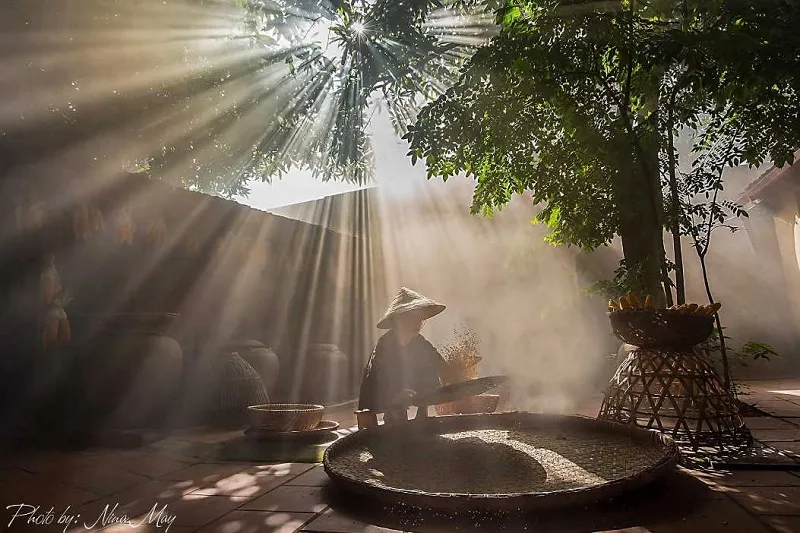
In addition, you can also enjoy other rustic dishes such as rau sắng (Melientha suavis), bánh tẻ (rice cake), bánh gio (ash cake), or various types of sweet soups and vối tea at eateries and restaurants in the village. Do not forget to buy Duong Lam chè lam as gifts for relatives and friends.
Detailed Duong Lam Ancient Village Travel Tips
To make your trip to Duong Lam ancient village more complete and meaningful, please refer to the following useful tips:
1. Ideal Time to Visit
The best time to visit Duong Lam is in the autumn (September – November) and spring (February – April). In autumn, the weather is cool and pleasant, the trees are green, and the natural scenery is vibrant. In spring, Duong Lam is filled with the colors of peach and plum blossoms, with fresh and new air. Avoid going in the summer (May – August) because the weather is hot and sultry, or in the winter (December – January) because it is cold and drizzly.
2. Means of Transportation
In Duong Lam ancient village, the ideal means of transport is walking or renting a bicycle. Walking helps you leisurely admire the scenery and feel the peaceful atmosphere of the countryside. Renting a bicycle helps you move faster and explore more places. Bicycle rental prices range from 30,000 – 50,000 VND/bike/day.
3. Entrance Tickets and Costs
- Entrance ticket to Duong Lam ancient village: 20,000 VND/person.
- Parking fee: 10,000 VND/vehicle.
- Food costs: Vary depending on your choice, from affordable eateries to luxury restaurants.
- Accommodation costs: If you want to stay overnight, you can rent guesthouses or homestays in the village at affordable prices. You should book rooms in advance, especially during peak tourist season.
4. Notes When Visiting
- Dress politely and discreetly when visiting communal houses, pagodas, and temples.
- Maintain general hygiene, do not litter.
- Respect local customs and culture.
- Ask for permission before taking photos inside people’s houses.
- Buy souvenirs and local specialties to support the locals.
- If you intend to stay overnight, bring necessary personal items.
- Bring a hat, sunscreen if going in the summer.
- Prepare comfortable shoes for walking a lot.
Conclusion: Duong Lam – A Destination Not to Be Missed
Duong Lam ancient village is not just a tourist destination, but also a journey back to the roots, rediscovering traditional cultural values. Here, you will immerse yourself in a peaceful, ancient space, explore the unique architectural beauty, experience the unique culture and cuisine, and feel the warmth and friendliness of the locals. If you are looking for a destination near Hanoi to escape the noise and bustle of the city and want to explore the beauty of the Vietnamese countryside, then Duong Lam ancient village is a perfect choice. Come and feel it, let Duong Lam touch your heart with beautiful memories and unforgettable experiences.